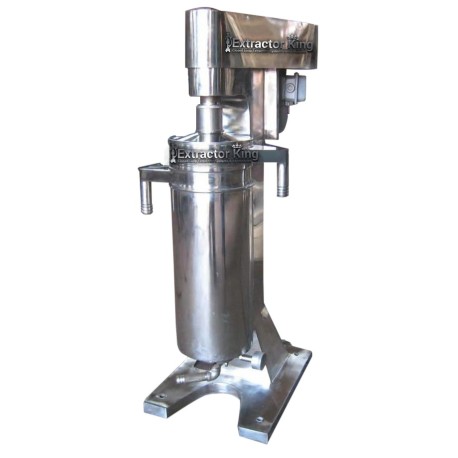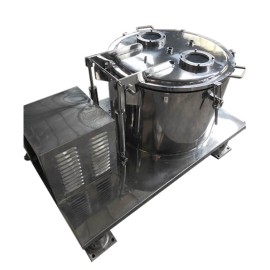Cart
0
Product
Products
(empty)
No products
To be determined!
Shipping
CAD $0.00
Total
Product successfully added to your shopping cart
Quantity
Total
There are 0 items in your cart. There is 1 item in your cart.
Total products
(tax excl.)
Total shipping (tax excl.)
To be determined!
Total
(tax excl.)
Centrifuge Extractors
- Closed Loop Extractors
- Turn Key Extractor Systems
- Extractor Parts & Accessories
- Vacuum Pumps
- Recovery Pumps
- Solvent Tanks
- Lab Equipment
- Carbon Chemistry
- Terpenes
- Dry Ice
- Safety Equipment
Centrifugal Separators 670L-3300L Per Hour
New
The Extractor King CS series separators are designed for liquid-based applications. Using centrifugal force to separate suspensions consisting of two or more phases of different densities. They can be used for liquid-liquid separation, liquid-liquid-solid separation or for liquid-solid separation. Our CS line of centrifugal separators have throughput capacities starting at 670 L/H up to 3300 L/H.
More info
| Models: | CS-75 | CS-105 | CS-125 | CS-150 | |
| Inner Diameter (mm): | 75 | 105 | 125 | 150 | |
| The Effective Height (mm): | 450 | 730 | 730 | 730 | |
| Volume (L): | 2.2 | 6 | 8 | 10 | |
| Speed of Rotation (rpm): | 21000 | 19000 | 17500 | 16000 | |
| Centrifugal Force (ω2.r/g ): | 22500 | 21000 | 21000 | 21000 | |
| Throughput Capacity (L/h): | 670 | 1700 | 2200 | 3300 | |
| Motor Power (kw): | 1.5 | 2.2 | 3.0 | 4.0 | |
| Dimensions(L×W×H) (mm): | 760×450×1120 | 840×500×160 | 900×550×1600 | 900×550×1600 | |
| Weight (kg): | 300 | 570 | 610 | 665 |
Applications
● Separation of liquid-liquid
● Separation of liquid-solid
● Separation of liquid-liquid-solid
Features & Benefits:
•Integration of the centrate collection cover and the discharge port: easy disassembly and cleaning of the discharge
component,and visible liquid purification process
• Rapid separations
• Consistent performance
• Small footprint saves space
• Simple to set up, use and clean for minimal down-time during operation
• The stainless steel contact parts such as the bowl interior in Stainless Steel, the stainless steel covers and certain
stainless steel drag components are polished to high sanitary standards to ensure functionally satisfactory
performance.
• Sanitary Construction for pharmaceuticals, chemicals,biologics and food processing including tri-clamp
connections, polished stainless steel housing and FDA approved elastomers.
The centrifuge is designed to separate two liquids of differing densities that may contain solids which are bigger than
0.001 microns in size. The centrifuges is an excellent replacement for many traditional filter and membrane
applications due to their high efficiency (virtually no product loss) and small footprint. Additionally, unlike
traditional filters, they never require pre-coating or back-flushing and can never clog.
Working principle:
The bowl turns at 16000 r.p.m.or higher, and generates a centrifugal force in excess of
21000 times the force of gravity. The mixture to be separated enters the nozzle of the
centrifuge placed at the bottom of the machine. The centrifugal force acts on the liquid
entering and separates the two liquids according to their specific gravities. The lighter
liquid forms the inside layer and heavier liquid forms the outer layer. Since the mixture is
entering continuously in the bowl, two phases are discharged continuously from two
separate liquid outlets provided on the top portion of the machine.
Solids are collected inside the bowl can be removed periodically.
Flow
Fluid flow in and out of the centrifuge is continuous. The heavier liquid phase and the lighter liquid phase are
discharged through their respective liquid outlets. If any solids are present they will be collected inside the bowl
and may be removed periodically.
Separation efficiency
Heavier liquid and lighter liquid are all separated. Solids capture of up to 100% is possible depending on product
characteristics and flow rate
Application of Stokes’ Law
Stokes'Law defines the settling rate of a particle in a fluid as the net effect of the drag on a particle
versus the gravitational force acting on the particle. In the centrifuge the gravitational force (g) is
multiplied by 15,000 to 21,000 times. Settling rate is most affected by particle diameter (d) and then
by the difference in density between the solids and the fluid medium (PP-Pf). The variables of particle
size and density differential are not easily controlled, but the remaining variable, viscosity (µ), can
often be altered to increase separation performance. According to Stokes’ Law, halving the
viscosity of the liquid will double the settling rate and, therefore, double the throughput of the
centrifuge. Viscosity can be reduced by increasing the temperature of the fluid or by direct
dilution by the addition of a lower viscosity fluid.
No customer reviews for the moment.









